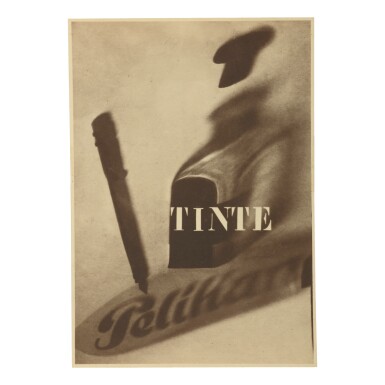Photographs
Photographs

EL LISSITZKY | PELIKAN TINTE
Auction Closed
April 5, 08:29 PM GMT
Estimate
300,000 - 500,000 USD
Lot Details
Description
Property from the Manfred Heiting Collection
EL LISSITZKY
1890-1941
PELIKAN TINTE
1924
8¼ by 5¾ in. (21 by 14.6 cm.)
El Lissitzky’s Pelikan Tinte, arguably among his most famous works, was created in 1924 during a period of intense creativity and stylistic transition for the artist. While being treated in Switzerland for tuberculosis, Russian-born Lissitzky accepted paid commissions to create advertising artwork for the Pelikan brand of inks and typewriter ribbon. Letters sent by Lissitzky to Sophie Küppers, his future wife, during this convalescence reveal an energized artist: ‘I have a great desire now to work on something of which direct use will be made. . . My hands are itching already, I have a whole lot of ideas’ (26 May 1924). Over a period of mere months, Lissitzky produced a series of imaginative photomontages, photograms, and poster designs (fig. 1) that remain revolutionary in the histories of photography and graphic design.
Although cameraless photography had been used since the birth of the medium, it was not until the early 20th century that interest was re-invigorated by a new generation of avant-garde artists, including László Moholy-Nagy, Man Ray, and El Lissitzky. While in Berlin in 1922, Lissitzky became acquainted with Moholy-Nagy and visited him at his studio. It was during this time that both men began experimenting with the plasticity of photogram technique, although with radically different results. In his essay ‘Fotopis’ (‘photo-writing’ or ‘photo-painting’), Lissitzky summarized his view of the photogram, ‘Without a camera, we use the varying degree of translucency of the object, and, most importantly, through the conscious organization of the light sources and the direction of their rays, we seek the construction of shadows which would render the object most characteristically’ (Sovetskoe Foto, No. 10, May 1929, translated and quoted in The Abstract Cabinet, pp. 17-8).
Pelikan Tinte combines photogram, photomontage, and typography to stunning visual effect. The ghostly form of an ink bottle floats across the image with its stopper flying above. A fountain pen – its ink tank perhaps recently filled – is clearly delineated; its position is angled as if having just finished writing the word ‘Pelikan’ on its own. The bright, stenciled lettering of the word TINTE (ink) punctuates the blurred background, rendering the finished image seemingly in three-dimensions. Lissitzky created a sense of dynamism and movement in this image by fully exploiting the flexibility of the photographic medium.
The importance of Pelikan Tinte within Lissitzky’s oeuvre is underscored by its significant early history of being illustrated in important publications including in Jan Tschichold’s groundbreaking 1928 treatise Die neue Typographie. Tschichold, an avant-garde typographer, was among Lissitzky’s fiercest defendants; he illustrated Pelikan Tinte several times alongside his theses on graphic design.
The photograph offered here is from the private collection of Manfred Heiting. Beginning in the 1970s, Heiting carefully built an encyclopedic collection of more than 4,000 photographs, tracing the history of the medium from 1840 to the present through his acquisition of the finest examples of every major photographer’s work. Long considered one of the finest collections, The Manfred Heiting Collection was acquired by the Museum of Fine Arts, Houston, in 2002. Among the photographs acquired by the Museum is another print of Lissitzky’s Pelikan Tinte (2002.1550). Prints of Pelikan Tinte are exceedingly rare but it comes as no surprise that Heiting, who trained as a typographer, would seek out two such outstanding examples. The present photograph has remained in Heiting's personal collection since it was acquired nearly 30 years ago.
At the time of this writing, it is believed that in addition to the print offered here only two other examples of this image have appeared at auction in the last three decades. In addition to the aforementioned photograph at the MFA Houston, prints of the image have been located in the collections of the Victoria & Albert Museum, London, and the Berlinische Galerie, Berlin.
